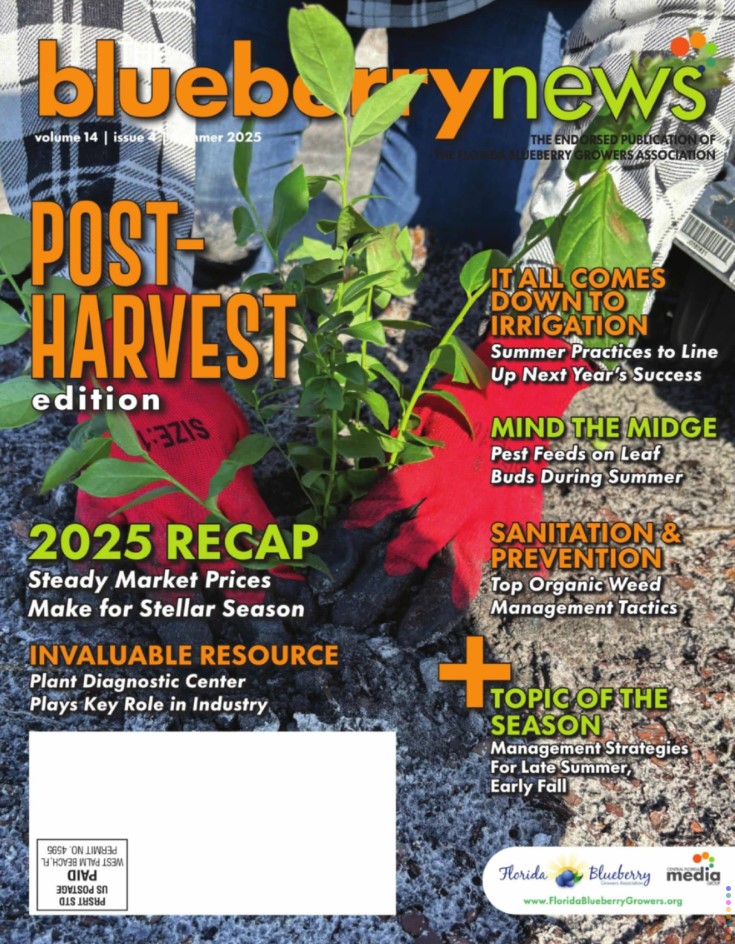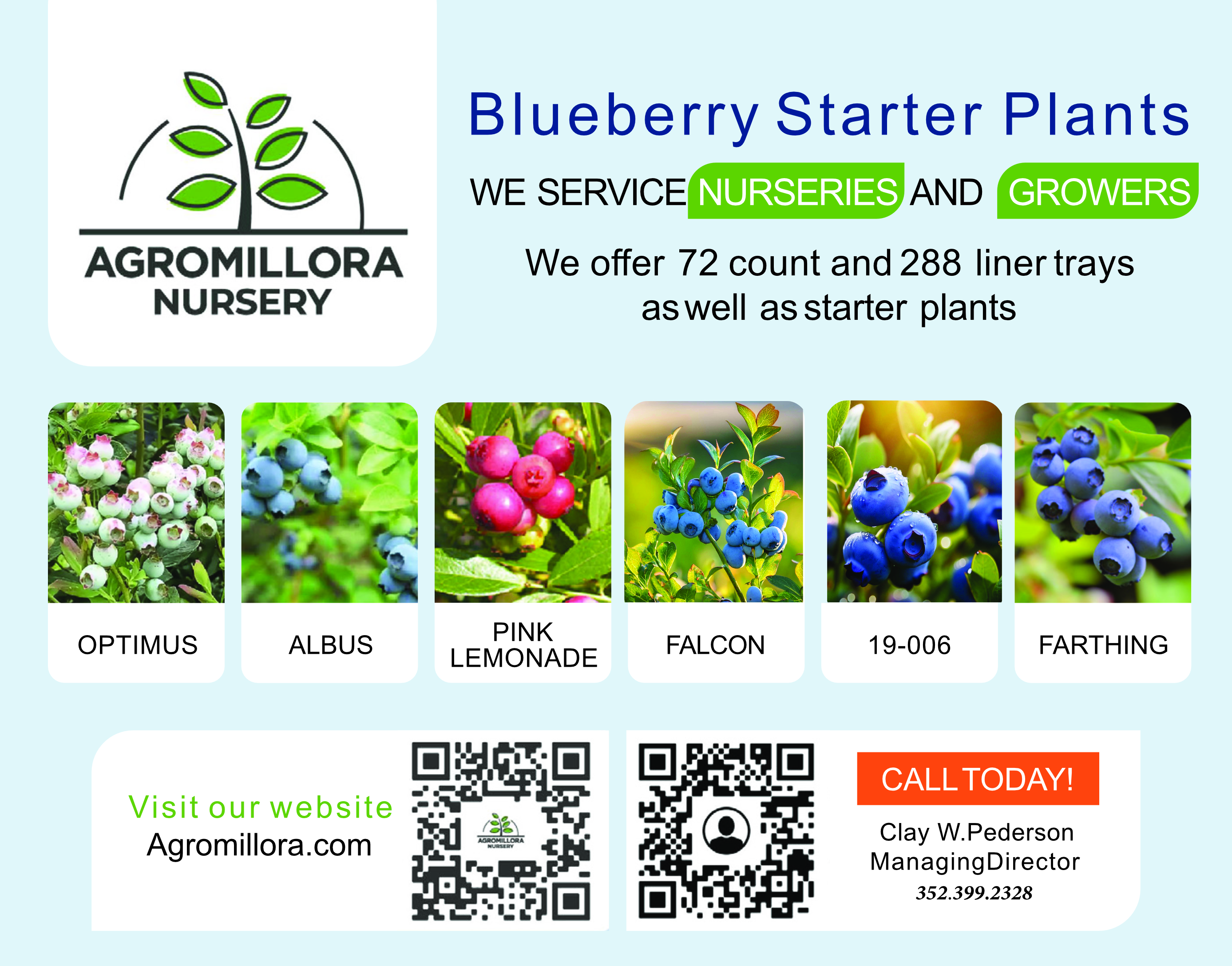How to Combat Algal Stem Blotch and Fungal Leaf Diseases
With the blueberry season over and summer upon us, it’s time to get ready for the diseases that will be issues for Florida growers over the next few months. A good scouting tool to use in monitoring for disease in the field is the UF/IFAS Blueberry Growers Guide. Resources in this guide include a diagnostic key, descriptions of symptoms, disease/insect life cycles, suggested management practices, an image gallery, and links to UF/IFAS blueberry extension publications.
The two primary disease areas to focus on during the summer and early fall months are algal stem blotch and fungal leaf diseases.
Algal Stem Blotch
Algal stem blotch, caused by a parasitic green alga (Cephaleuros virescens Kunze), is a significant disease on southern highbush blueberries in Florida. This disease results in stunted plant growth, increased susceptibility to Botryosphaeria stem blight due to cracking stems and canes, and in some cases plant death.
The alga, spread by water splash, is thought to enter the plant through natural or mechanical wounds, or by directly penetrating the plant cuticle. Plants that are stressed by abiotic or biotic factors are more susceptible to infection and subsequent disease development. Once colonies form in the plant, it typically exhibits raised red blotches on young stems, which can enlarge into cankers that encircle the canes (Figure 1). In addition, significant chlorosis of the leaves (pale yellow to white) occurs on infected canes (Figure 2). During hot, humid, and wet summer conditions, reproductive structures emerge, spreading the pathogen to uninfected tissue in the same or adjacent plants. These structures appear as bright-orange feltlike mats or tufts of algal growth, emerging from lesions on young stems and older cane surfaces (Figure 3).
Figure 1. Algal stem blotch lesions.
Credits: P. Harmon
Figure 2. Plant with chlorotic leaves and stunting due to algal stem blotch infection.
Credits: P. Harmon
Figure 3. C. virescens reproductive structures.
Credits: D. Phillips
Algal diseases are only problems for blueberry production in Florida but are common problems for tropical crops including avocado, citrus, guava, and many others. Our blueberry management strategies were assembled from research conducted on those crops and limited blueberry work and observations. Certain cultural practices can help reduce the spread of disease, including use of disease-free planting stock, good management practices to reduce plant stress, avoiding or minimizing the use of overhead irrigation, controlling weeds to promote improved air circulation in the plant canopy, removing and destroying infected canes, and disinfecting pruning equipment. Some varieties develop more algal stem blotch than others, and variety resistance is a direction for future research.
Chemical controls are limited to copper product sprays such as copper hydroxide, which can help protect healthy canes from becoming infected and kill algal spores on the outside of infected plants. These products protect healthy canes from infection for a few days following application, but they cannot impact existing symptoms or eradicate the disease in the plant. A few growers have reported some success in helping minimize spread through spray applications of peroxyacetic acid products, but unlike copper, there are no studies that have shown these products to significantly impact disease spread or development. Most modern fungicides are specific to fungi and have no effect on algae or algal stem blotch.
Copper product applications should begin following harvest and continue through September. Spray applications must be done on a regular schedule prior to infection in order to be effective, and spray equipment must achieve good cane coverage. Specific spray schedules and application rates vary with the label instructions of the selected product, with reapplication intervals ranging from 7 to 28 days. More frequent applications (usually at the lower label rates) are recommended when weather forecasts are favorable for disease development and when the disease is known to be present on the farm. Caution should be exercised when tank-mixing products that contain copper with anything else, making sure to follow all label directions and warnings. Tank mixes of acidic products or acidifying adjuvants and copper can result in plant burn, and tank mixes of copper products and products with penetrants or spreader sticker type formulations can also be problematic in some conditions (Bravo Weatherstik is an example). For specific product rates, timings and details, see the UF IFAS Blueberry Integrated Pest Management Guide (http://edis.ifas.ufl.edu/pdffiles/HS/HS38000.pdf).
More details on algal stem blotch can be found in UF EDIS Publication PP344, Algal Stem Blotch in Southern Highbush Blueberry in Florida (https://edis.ifas.ufl.edu/publication/pp344).
Fungal Leaf Diseases
Several fungal leaf diseases can be problems for Florida blueberry growers during the summer months. These include anthracnose, Phyllosticta leaf spot, rust, and target spot.
Symptoms with different causes can have similar appearances, and more than one disease can occur on the same leaf. To know for sure, growers should consult UF IFAS Extension or use a lab-based diagnostic service. Blueberry plant disease samples can be sent to the UF/IFAS Plant Diagnostic Center (https://plantpath.ifas.ufl.edu/extension/plant-diagnostic-center/) or another diagnostic lab.
Table 1 at the end of this article presents information on when fungal leaf diseases are usually observed, along with some suggested fungicides for disease management.
Anthracnose
Anthracnose leaf spot can cause premature defoliation, poor bud development, and subsequent loss of yield. Symptoms are circular to irregularly-shaped lesions usually at the edges of leaves, expanding from ¼ inch to greater than ¾ inch in diameter. The centers of lesions are necrotic and can be brown to dark-brown, with bull’s eye patterns sometimes present (Figure 4). This disease is commonly observed after harvest in Florida and continues through the summer.
There are several fungicides labeled for anthracnose on blueberry in Florida, including DMI fungicides such as IndarTM, OrbitTM, QuashTM, Quilt XcelTM and ProlineTM. These can be used in rotation or in tank mixtures with compatible products from another group to help prevent fungicide resistance, including Luna TranquilityTM, AboundTM, PristineTM, SwitchTM, and captan. Single applications of BravoTM can also be used after harvest. Applications work best before symptoms become severe. On susceptible varieties, applications to manage foliage health through flower bud differentiation should begin after post-harvest pruning, with reapplications according to label instructions through September. Anthracnose resistance to AboundTM has been confirmed in central Florida, so it should be tank-mixed with another fungicide like a captan product.
Figure 4. Anthracnose leaf spot lesion.
Credits: P. Harmon
Phyllosticta
Phyllosticta leaf spot is more common later in the summer than anthracnose (August-September). Symptoms are brown leaf spots with irregular borders, surrounded by a purple or dark brown margin, and size ranging from small (less than 1/8 inch) to larger than one inch. A characteristic feature is the presence of tiny black fungal pimples within the lesions (Figure 5), although other fungi can have similar structures.
There are no published fungicide recommendations for the management of Phyllosticta leaf spot management on blueberry, although in other crops related diseases are managed with applications of the contact fungicide BravoTM. Applications are suggested after harvest and approximately every two weeks thereafter (up to 6 weeks) within label instructions.
Figure 5. Phyllosticta leaf spot symptoms.
Credits: P. Harmon
Rust
Blueberry plants Infected with rust can exhibit premature defoliation, decreased floral bud differentiation, and reduced yield. All southern highbush blueberries are susceptible to this disease, although certain cultivars including “Jewel” are known to be more susceptible than others.
Symptoms are typically observed first on upper leaf surfaces as small, somewhat angular yellow to reddish brown spots that may turn black over time before defoliation occurs. Yellow and orange spores are produced on the underside of leaves opposite the lesions on the surface (Figure 6).
Rust spores are spread by wind, and in evergreen systems and protected culture the pathogen can survive in infected leaves that remain attached to the plants throughout winter. New leaf infections can begin in spring during or just after harvest, and disease activity increases again in early fall.
Figure 6. Rust reproductive spores on the leaf underside.
Credits: P. Harmon
Application ofsystemic fungicides is the best method of control. Fungicides do a better job protecting against new infections than treating existing ones, so repeated applications to maintain a protective residue on the leaves are key to preventing the disease. Effective fungicides include OrbitTM, IndarTM, QuashTM, ProlineTM, PristineTM, and BravoTM, with ProlineTM standing out in some research as excellent. Begin applications after harvest and continue through late October on susceptible varieties. Fungicides with different modes of action should be used in rotation or in a tank mix.
Target Spot
Target spot, caused by Corynespora cassiicola, has become an increasingly problematic disease for Florida blueberry growers. It was first reported in blueberries in the US in 2014, and Florida growers have observed severe defoliation on many SHB varieties since then. Symptoms are angular to irregular, reddish-brown lesions, 1/3 to 3/8-inch in diameter, with color varying in concentric rings, resulting in a “target” or bull’s-eye pattern (Figure 7). Symptoms can be similar to early symptoms of anthracnose leaf spot, and both diseases can occur on susceptible varieties at the same time. However, target spot lesions typically remain smaller, and fewer target spot lesions are required before defoliation occurs compared to anthracnose.
Fungal spores can be spread by both water splash and wind. Summer and early fall conditions including high humidity, temperatures between 79°F - 84°F, and moderate rainfall favor abundant fungal sporulation and rapid development of disease.
Growers have reported difficulty managing target spot after symptoms are observed and become severe. Preventative fungicide applications where the disease is known to be present or careful scouting for initial disease symptoms are encouraged. No fungicide resistance is known at this time, and most fungicides that are used to manage anthracnose and rust should be effective against target spot. Chlorothalonil (Bravo and other products) specifically has a very broad-spectrum of fungal activity and is used to manage target spot effectively in other crops. Blueberry cultivars vary in their susceptibility to target spot and ongoing research will provide additional information. Growers should ensure good, even coverage and canopy penetration with spray equipment to increase the efficacy of the fungicide products they apply. See Target on Southern Highbush Blueberries in the spring issue of The Blueberry News for additional control options.
Figure 7. Target spot symptoms.
Credits: P. Harmon
Additional information on leaf diseases can be found in UF EDIS Publication PP348, Florida Blueberry Leaf Disease Guide (https://edis.ifas.ufl.edu/publication/PP348).
General Fungal Leaf Disease Management
Good management practices can be utilized to reduce the onset and severity of fungal leaf diseases. For example, the use of drip irrigation, or timing overhead irrigation to be used during periods when dew is present, reduces the amount and duration of leaf wetness and corresponding disease. Implementation of good sanitation practices is also recommended. Removal of infected plant debris helps to prevent fungi from overwintering and creating a potential source of infection in the spring. In addition, it is essential to minimize the risk of fungicide resistance or insensitivity in pathogen populations. It is recommended to utilize fungicides with different modes of action, maintain an appropriate fungicide rotation program, avoid the exclusive use of a single fungicide or active ingredient, and implement an integrated disease management program. The Fungicide Resistance Action Committee also recommends following fungicide label directions, using products at the indicated dose rate, limiting the number of applications, and performing chemical sprays only when absolutely necessary.
credits:
DR. PHIL HARMON, Professor, Plant Pathology, University of Florida
DOUG PHILLIPS, Blueberry Extension Coordinator, University of Florida
Table 1. Seasonal leaf disease calendar for deciduous Florida blueberry production. Green shaded months indicate when the listed diseases are most likely to occur during a season, and when fungicides may be most effective.





